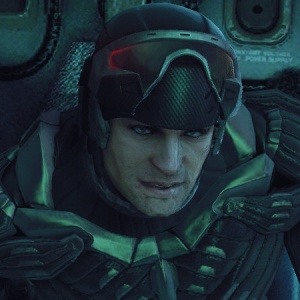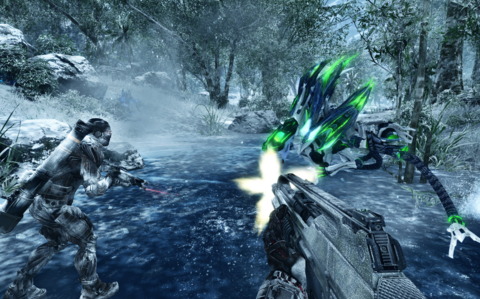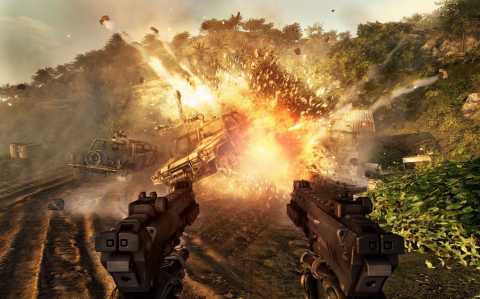Last November, Crysis stood out as one of the biggest--and weirdest--game releases of the year. After years of build-up, this amazing-looking shooter with mountains of hype finally hits stores, and it turns out not a lot of people have the hardware to run it--and of those that do, only a minority is willing to actually pay for the game. Bummer.
A year later, developer Crytek has learned some lessons from the original Crysis launch. Producer Bernd Diemer and reps from publisher Electronic Arts recently came through town and let me play a new demo level from Crysis Warhead, the new standalone quasi-sequel that's out next week. After the demo, I sat down with Diemer to pick his brain about whipping out a second Crysis in such a short time period.
Sadly not covered in this interview: the significant addition of both Cryses to Steam, a platform where you'd scarcely have seen any EA-branded product before now. Granted, Crytek is an independent studio and EA is merely its publisher, so don't look for every EA game to hit Steam in the near future, but this is still great news for anyone who wants to grab Warhead in a downloadable format. On with the interview!
You just put out Crysis last year, and less than a year later you've got a new one. Obviously, you needed a second studio to pull that off. Can you talk about where those guys came from, how they joined the Crytek family and what they contributed?

Then [Crytek founders] the Yerlis brought in Crytek Budapest as the third studio in our family; we had Crytek Kiev before that. But back in the day it started out with Kiev being more like an asset supplier, they did a lot of graphic assets for the original game. That didn't work out too well, because the team over there is really talented, and their heart wasn't in doing just assets. One of our guys said "hey, do me a jeep," and they did a jeep, but they didn't know what for, exactly, or who the guy was they were talking to. So it very often happened that they did something which they were very proud of, sent it over to us and we were like, "Yeah, it looks great, but it's wrong. Doesn't fit." And so it went back and forth, back and forth, and after that, we decided it fits a lot better with our company strategy if studios work on their own projects. So we started in Kiev to work on a project which we haven't announced yet, and then during the finalling of Crysis, the Yerlis decided to build up the studio in Budapest.
So we flew [the Budapest staff] over to Frankfurt, to our main office, for training, to get them used to the editor and meet the team and everything. At that time, they told me to deal with these guys. So I was there in the middle of finalling a game, a thousand bugs coming in a day, the usual panic, and then suddenly we have 20 dudes with funny names and a funny language sitting there [laughs], and I was supposed to give them something to do. Then we said, "Well, why not this ex-pack thing, because we don't have time to focus on it." What we did was we gave them our box of toys and said, "Guys, this is Crysis, here's the editor, here's what we did. These things work really well, these things don't work so well. Think about improving it, or what you can do with it to make it better." And they went away and did prototypes, mainly engine videos, of what Warhead could be. They did that for two weeks, and then did a demonstration for us, and what they showed us was amazing, and we were very impressed. Then we said, "This is way too much for an ex-pack, just give these guys their own project. Let's say it's Warhead, it's standalone, and let these guys do it."

That drove a lot of design decisions because we focused on the stuff he likes to do. He's the British bloke who likes to blow stuff up. We looked at the game and said "How can we pack in more explosions, more exciting things happening?" and focus on a main path where stuff gets damaged around Sykes--either he's doing the damage or there's a lot of stuff blowing up. In the one level where we have the squad support, even if you yourself aren't doing that much, it's kind of like carrying around your own action bubble, there's always something going on. The guys are saying things, Sykes is a lot more vocal than our old main character. That basically drove our whole design, the additions to the original Crysis vision: if you have to sum them up, it's Sykes and blowing stuff up. [laughs]
The only thing that stopped me from playing the first Crysis was not being able to run it well. On my machine the demo ran...okay on medium settings. You guys have addressed that in Warhead. What exactly have you done?
We started off optimizing it after we finalled Crysis. We made a tech drop to the Budapest guys, and said "Here, this is it, take a look at what can be improved." The main areas we asked them to look at were general engine performance, AI, stuff that moves particle effects, explosions, objects, things like that. They looked at that and managed to improve it. On the other hand, you know how designers are: you give them more performance, they put in more stuff. So it became a kind of feedback loop, where we continuously improved it but at the same time we had more stuff going on at the same performance.
In our editor we have budgets, we have a red bar that blinks if you've exceeded, for example, your polygon budget--but nobody really cares [laughs]. So the way we dealt with this was, we put together a PC which back then cost about $700 and put it in the middle of the studio and said "Guys, this is where we're going to have all our milestone presentations, where we're going to show off the game to the Yerlis, to EA Partners, so on this machine it has to look really good, it has to play well, and it has to support this hardware generation." So we called it the Warhead PC, and the R&D guys had to put a lot of effort into reining in the design team, saying "No, wait, you have to do it that way." Then we had this sort of boundary you couldn't cross, because the PC was like the oracle. If somebody came up with something fancy and new, we'd say "Let's put it on the PC, see how it does." That helped us a lot in the development.

Piracy was a big issue with the sales of the first Crysis. Are you doing anything new to combat that with this release?
We do have plans, but we're not talking about them because it's a very, very, let's say, sensitive topic. There's a lot of emotions on both sides--well, on three sides. You have the developer, us, who put a lot of effort into a game and who want it to be appreciated. And for developers, because we want to get paid, being appreciated means people actually buy the game. [laughs] We have a publisher, who is also in the business to make money.
And on the other hand, what you shouldn't forget is that you also have your customer. It's a very delicate balance between punishing legitimate owners who bought the game--if it doesn't run for some reason or if the copy protection is too aggressive--and on the other hand, ensuring that it doesn't get pirated too much. So that's something we're very careful with, and we're looking at what's on the market, what we can do, what EA can do to support us, and hopefully come up with the best solution for everybody.
Obviously it's a very emotional topic, as you've seen from what Cevat [Yerli, CEO] or whoever from Crytek or EA says on the web, or even other developers. It's very hard to deal with this issue and there isn't one simple solution which can solve that.
Speaking of Cevat, he's made recent comments about the next generation of the CryEngine hitting in 2012 with the new consoles, that this time period will be marked by "a renaissance of graphics programming," and that the new engine will offer three to five times the image fidelity of what we have now. Crysis is still nearly the best-looking thing on the market, so where do you go from here to make this thing better?

The next big challenge is for all the other systems to catch up. Animation, AI, particles, physics, because if you look at games the way they are now, as long as the scene is not moving, it looks perfect. But the moment people start moving, you see that something is off. It's not enough to have a guy who looks photo-real; if he moves like a zombie, the illusion is broken. If the physics are off--which nowadays they still are because you have to simplify physics a lot--where polygons are concerned, or textures, you can do pretty much whatever you want nowadays, with the hardware and software you have. But physics and AI are still too simplified. AI, you only notice if it's bad. Currently, the systems and the engines we have don't support believable AI unless you simplify it too much. The next big challenge is getting all these systems up to where the graphics already are.
Where photorealism is concerned, it will be a lot more about art direction. If you compare it to movies, which are photo-real, because you just film what is out there, there are certain ways directors achieve a very unique visual style, which makes things real although they are not real. One example from the past is Jurassic Park, with the dinosaurs. I caught myself in the cinema saying "Wow, these dinosaurs look completely real." How the hell do I know? I've never seen a real dinosaur. The trick is, with art direction and creative minds, you make things believable and behave [realistically] although they don't exist in the real world. This is where engines need more on the tool side, on the creative control you can exert over this amount of technology, which is amazing. But to make this thing work and behave in a believable way, where people will say "Wow, these aliens look real" and make this switch in their own minds that they accept the world as it is, although it's not a real world. For that, you need a new engine and new tools and a new hardware generation.
I believe this will take some more time to achieve that, but it's a very nice challenge. If you look at games and how close they are to movies, a lot of people are talking about that. For example, what Pixar does, they can take a glass and give it a personality. And people will look at it, like the small robot in Wall-E, which is a movie almost entirely without dialogue. This is something we still lack in games, where you have the tools and the systems to create a believable artificial world which people will accept and not get thrown out of the world but stay in their suspension of disbelief, that you as the user accept it, because it looks real and it feels real. It doesn't mean it has to be photo-real, but it has to be believable.
Thanks Bernd!
32 Comments